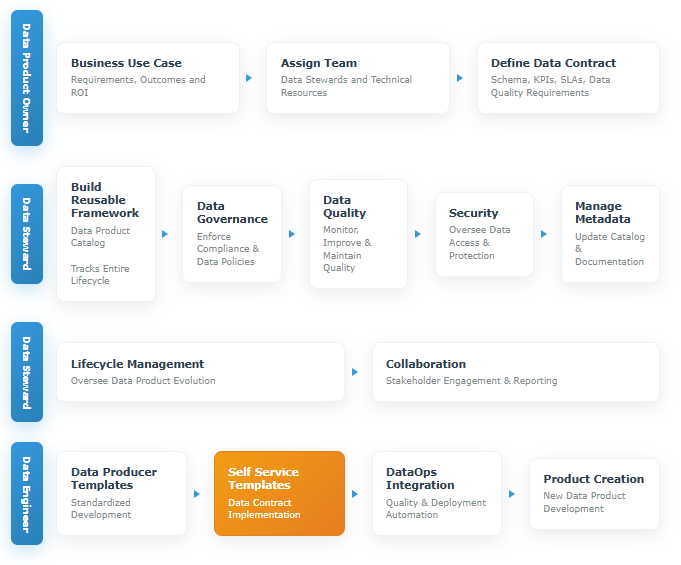From Chaos to Contracts: How Metadata Powers the Future of Trusted Data Products
The era of treating data like a byproduct is over. In modern, AI-enabled enterprises, data must be managed as a product—complete with ownership, SLAs, quality enforcement, and accountability. But this shift doesn’t happen by accident. It requires metadata-driven governance at every stage of the data lifecycle.
At InfoLibrarian™, we believe the foundation of this transformation is metadata-as-code—and specifically, data contracts that act as enforceable agreements between producers and consumers. These contracts encode everything from schema and constraints to quality rules and SLAs, turning governance into infrastructure, not afterthought.
What Is a Metadata-Driven Data Product?
A data product is a reusable, trusted dataset managed with the same rigor as a customer-facing software product. Each product includes:
- Clear ownership and stewardship
- Defined schema, constraints, and SLAs
- Embedded data quality rules
- Rich business metadata and discoverability
By managing metadata as code, these products become auditable, testable, and governable—supporting automation, self-service, and compliance at scale.

Strategy in Action: Data Product Operating Model
Our advisory services aren't theoretical — they're embedded directly into a modular, metadata-driven platform. See how data stewardship, governance, and domain-driven design come together in InfoLibrarian™’s operational model for trusted data delivery.
Shift Left: Governance at Ingestion, Not After
Traditional governance approaches try to fix data after it hits the warehouse. But by then, it’s too late. Shift-left governance means enforcing standards at the point of data entry—at ingestion—not retroactively in BI tools or catalogs. Shift-left governance means enforcing data standards at ingestion, not after processing, ensuring quality from the start.
✅ InfoLibrarian enforces:
- Schema validation at ingestion
- DQ rules before data hits pipelines
- SLA compliance and lineage tracking from the start
- Contract violations before they cause downstream breakage
Anatomy of a Data Contract
{
"urn": "urn:product:customer_orders",
"schema": {
"order_id": "string",
"customer_id": "string",
"order_date": "date",
"total": "decimal"
},
"dq_rules": {
"order_date": "must not be in future",
"total": "must be >= 0"
},
"sla": {
"availability": "99.9%",
"freshness": "daily by 8am"
},
"business_metadata": {
"domain": "Sales",
"description": "Captures all customer order and revenue events.",
"product_owner": "sales-analytics@company.com",
"tags": ["sales", "orders", "revenue"]
}
}
Each Contract Defines:
- Schema & constraints
- Data quality rules
- Service levels
- Business context and discoverability
This becomes the authoritative definition for the data product—governed, validated, and shareable via metadata APIs and catalogs.
The Data Product Lifecycle
Metadata-powered governance supports every stage of the data product lifecycle:
1. Define & Design
- Use cases & product requirements
- Schema & contract design
- Business metadata & ownership
- DQ rules and SLAs
2. Develop & Test
- Enforced contract validation
- Pipeline development with automated tests
- Lineage & dependency mapping
3. Deploy & Monitor
- Push to catalogs & marketplaces
- SLA tracking & DQ monitoring
- Consumer feedback loops
From Metadata to Marketplace
Once governed data products are defined and validated, they must be discoverable, requestable, and accountable across the enterprise.
Governed Data Products enable:
- Integration with enterprise data marketplaces
- Rich metadata search and tagging
- Request workflows & access control
- Federated domain publishing via metadata APIs
By embedding governance in metadata, we eliminate the friction between data producers and consumers—while maintaining security, compliance, and traceability.
At InfoLibrarian We Applied this to
Case: A&E Television + Netflix Syndication - Leveraging our 15+ years, InfoLibrarian™
By standardizing metadata definitions and enforcing data contracts at ingestion:
- helped harmonize 15+ media asset systems, reducing manual taxonomy mapping by 80%.
- Metadata exchange with Netflix was seamless and meta-model-compliant
- Manual taxonomy mapping was reduced by 80%
Why This Matters for Your Data Strategy
- Compliance: Automate enforcement of regulations (GDPR, HIPAA, etc.)
- Scalability: Shift from manual governance to automation
- Reusability: Enable cross-team data product delivery
- Accountability: Ensure contract compliance and traceability
- AI Readiness: Deliver clean, contextualized data to AI pipelines
About the Author
Brian Brewer, CTO of InfoLibrarian™, brings over 20 years of consulting experience, leading SMBs and enterprises to architectural success. His Metadata Value Method™ emerged from this journey, now driving the company’s modernization mission. Learn more about my journey in my story or our history on the company page to see how this transformation began.

